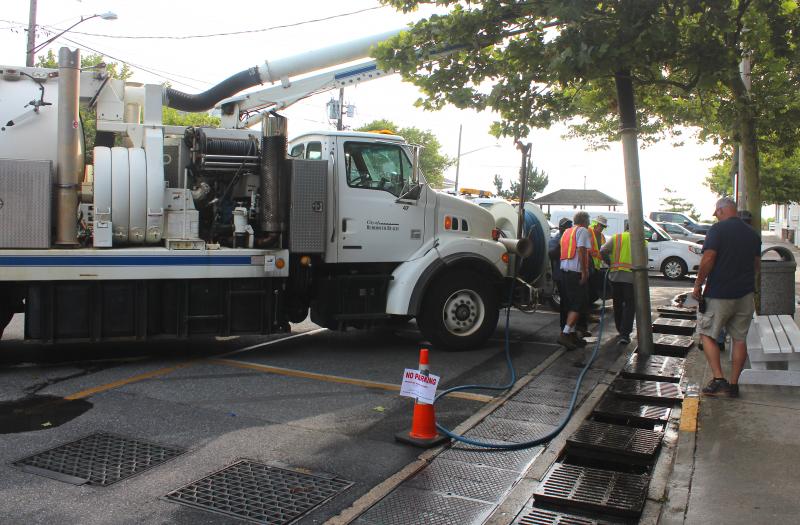Making good on a promise made to city commissioners, Rehoboth Beach Public Works Director Kevin Williams has figured out what caused the failure of the system designed to pump the dirtiest rainwater from Rehoboth Avenue into the city’s sewer line.
The sealants on the pumps are broken, which allowed the interior of the pumps to get wet, said Williams, July 18, as he oversaw the cleaning of the storm drains on Wilmington and Rehoboth avenues.
Williams, who has been working for the city for seven weeks, told the commissioners at a July 9 commissioner workshop he would figure out the problem. The promise came during an update on a stormwater report that showed after a heavy rainfall, stormwater pipes in parts of the city contain extremely high levels of enterococcus bacteria.
The $250,000 stormwater report was first presented to city officials in May by international engineering firm GHD. Study data showed in the six hours immediately following six major storms during the study period, pipe water in the city’s five stormwater outfalls from Grenoble Place south to Delaware Avenue averaged nearly 2,000 colony-forming units of enterococcus bacteria per 100 milliliters. The recommended level of colony-forming units is zero to 60. The state issues a swim advisory when the number of units is above 104.
GHD presented several options to the commissioners to ensure bacteria levels would be within recommended limits, but the report ultimately recommends the only way to keep the ocean waters near the shoreline below 60 units all the time is to extend four of the five stormwater outfalls 1,200 feet, at an estimated cost of $15 million.
Evaluate system first
Williams said he thinks the city needs to evaluate the system before officials discuss extending the outfalls.
“You’ve got to remember, when these systems were built decades ago, people weren’t concerned about bacteria. They were only concerned with oils and trash at the time,” he said.
Still to be determined is why the city didn’t know the pump was broken for up to two years.
City Manager Sharon Lynn, who was also on hand for the July 18 cleaning, said ultimately the buck stops with her. She said when she started four years ago, things were held together with Band-Aids, and she’s had to rely on the department heads to update her on the city’s infrastructure systems.
Lynn said this is why, for years, she’s been pushing to hire a public works director. The city did not have the right staff in place, she said.
Leita Bennett, senior project manager for GHD, said July 18 the broken pump was discovered during sampling, which ran from early August to October 2017. She said before informing the city about the problem, the company first had to determine whether the pump wasn’t working at all or if the pump wasn’t working only on the day of testing.
Bennett said the city was not informed of the problem before April.
Lynn said the city didn’t act immediately when it found out about the broken pumps because Williams was about to begin his job.
Williams said the pumps sit in water all the time. He said the plan is to fix the pumps immediately, which will cost about $2,000 each, and then figure out the best way to run the system.
Lynn, Williams and Bennett said even after discovering the pump was broken, it was appropriate to continue the study, because the bigger issue is the source of the enterococcus.
“We don’t want it in the vault to begin with,” said Bennett.
Another question with no apparent answer is why GHD failed to include information about the broken pumps in its report.
Lynn said she had nothing to do with that decision. Bennett said it was included the report. A thorough reading of the report reveals no obvious indication of the broken pump. Bennett could not be reached for further clarification.
Recreational water monitoring
Despite the broken pump and yet-to-be-discovered source of high enterococcus levels, the ocean appears to be passing state tests for cleanliness.
According to Delaware Department of Natural Resources and Environmental Control’s Recreational Water Program website, since May 7, stormwater outfalls as Rehoboth and Virginia avenues, Queen Street and Deauville Beach have been sampled 22 times each.
Only one time, June 13, at Rehoboth Avenue, did any of the samples show colony-forming units of enterococcus above 40 per 100 milliliters. DNREC’s policy is to issue water advisories when the number of colony-forming units per 100 milliliters is above 104.
The data shows no colony-forming units of enterococcus for 13 of the 22 samples at the Virginia Avenue, Queen Street and Deauville Beach stormwater outfalls. At Rehoboth Avenue, on six tests no-colony forming units were found.
Bennett said there could be a number of reasons why water sampling by the state is different from GHD’s sampling in the pipes. Stormwater dilutes quickly, and the water flow changes direction, so if the state testing does not take place immediately, the tests won’t show the bacteria, she said.






















































